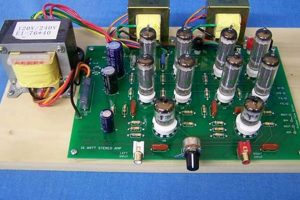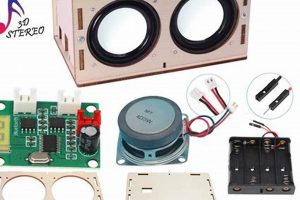Construction of unmanned aerial vehicles from component collections offers enthusiasts and professionals a hands-on approach to understanding drone technology. These assembled systems typically include a frame, motors, electronic speed controllers (ESCs), flight controller, power distribution board, and receiver. As an example, an individual may procure a pre-packaged assortment and, by following provided instructions, assemble a fully functional quadcopter.
The practice holds significance due to its capacity to foster technical expertise and provide customization options not available in ready-to-fly (RTF) models. Historical context reveals a gradual shift from entirely self-sourced parts to comprehensive packages, driven by increased accessibility of components and improved documentation. Benefits encompass enhanced troubleshooting skills, greater control over system performance, and reduced costs compared to pre-built alternatives.
The subsequent sections will elaborate on component selection criteria, assembly techniques, programming considerations, and safety protocols relevant to the construction and operation of user-assembled aerial vehicles. Furthermore, legal regulations and ethical considerations surrounding their usage will be addressed.
Essential Guidance for Assembling Unmanned Aerial Vehicles
The following guidelines are crucial for individuals undertaking the construction of a custom aerial vehicle from component form. Adherence to these points ensures both operational efficacy and mitigates potential safety risks.
Tip 1: Component Compatibility Verification: Prior to assembly, meticulously verify compatibility among all system components. Motor Kv ratings must align with ESC specifications, and the flight controller must be suitable for the chosen receiver protocol. Incompatible components can result in system instability or hardware failure.
Tip 2: Precise Soldering Techniques: Employ appropriate soldering techniques when connecting wires and components. Cold solder joints exhibit high resistance, leading to voltage drops and potential system malfunction. Use a temperature-controlled soldering iron and appropriate solder flux.
Tip 3: Secure Wiring Management: Implement a robust wiring management system to prevent entanglement with propellers or interference with sensitive electronics. Employ cable ties, heat shrink tubing, and secure mounting points to organize and protect wiring.
Tip 4: Thorough Flight Controller Calibration: Properly calibrate the flight controller before attempting flight. This includes accelerometer calibration, gyroscope calibration, and magnetometer calibration (if applicable). Incorrect calibration results in unstable flight characteristics.
Tip 5: Pre-Flight System Checks: Conduct comprehensive pre-flight system checks prior to each flight. Verify motor direction, propeller attachment, battery voltage, and radio link integrity. Address any anomalies before initiating flight.
Tip 6: Software Parameter Optimization: Optimize software parameters within the flight controller firmware to match the vehicle’s physical characteristics and intended flight profile. PID tuning is essential for achieving stable and responsive flight performance.
Tip 7: Range and Failsafe Testing: Conduct thorough range testing and failsafe testing before extending the flight envelope. Ensure that the vehicle returns to home or lands safely in the event of signal loss.
Adherence to these guidelines will enhance the likelihood of a successful build, improve flight performance, and minimize potential hazards. The subsequent section provides information about regulatory compliance.
1. Component Selection
Component selection constitutes a foundational element within the practice of drone construction from kits. The careful consideration of individual parts directly influences the overall performance, stability, and safety of the assembled unmanned aerial vehicle. A mismatch or inadequate selection of components may result in diminished flight capabilities, premature equipment failure, or potentially hazardous operational conditions. For example, selecting motors with an insufficient thrust-to-weight ratio will prevent the aircraft from achieving stable flight, whereas improper matching of motor Kv ratings with propeller sizes can lead to excessive current draw and ESC (Electronic Speed Controller) failure. The process of selecting appropriately specified parts is, therefore, not merely a matter of assembling a collection of components, but rather a critical engineering decision that determines the operational limits and reliability of the resultant aerial vehicle.
Further illustrating the practical significance of informed component selection, consider the impact of flight controller choice. Flight controllers vary significantly in processing power, sensor accuracy, and supported features. A flight controller with inadequate processing power may struggle to maintain stable control during complex maneuvers, leading to erratic flight behavior. Conversely, a flight controller lacking specific sensor capabilities (e.g., a barometer for altitude hold) will limit the drone’s autonomous functions. Similarly, the selection of battery capacity and discharge rate directly affects flight time and available power. Insufficient capacity restricts flight duration, while an inadequate discharge rate can lead to voltage sag under load, potentially causing the aircraft to crash. These considerations highlight the intertwined nature of component selection and overall system performance.
In conclusion, meticulous component selection is paramount to the success of any “drone kit diy” endeavor. Understanding the interdependencies between individual components and their impact on system-level performance is crucial. Addressing potential challenges, such as sourcing reliable components and navigating conflicting technical specifications, is essential for achieving a safe and effective operational unmanned aerial vehicle. The broader implications of effective component selection extend beyond individual project success, impacting the safety and responsible use of this technology.
2. Soldering Precision
Soldering precision represents a critical factor in the successful construction and operation of drones assembled from kits. Within the context of “drone kit diy,” improper soldering introduces potential points of failure that can manifest as intermittent connectivity, signal degradation, or complete system malfunction. The density of electronic components within a typical drone necessitates meticulous soldering practices to ensure secure and reliable electrical connections. A poorly executed solder joint, characterized by insufficient heat or inadequate solder application, creates a high-resistance pathway, impeding current flow and potentially damaging sensitive electronic components.
The consequences of imprecise solder
ing are multifaceted. Operational instability can arise from intermittent power delivery to motors or sensors, resulting in erratic flight behavior or complete loss of control. Short circuits, caused by solder bridges between adjacent pads or component leads, can lead to catastrophic damage to electronic speed controllers (ESCs) or the flight controller itself. Moreover, vibrations experienced during flight exacerbate the effects of weak solder joints, accelerating their degradation and increasing the likelihood of in-flight failures. A practical example involves the connection of battery leads to the power distribution board (PDB). A weak solder joint at this critical junction can lead to voltage sag under load, causing the drone to suddenly lose power and crash. Similarly, improper soldering of signal wires to the flight controller can disrupt communication between the receiver and the flight controller, rendering the drone unresponsive to pilot commands.
In summary, soldering precision is not merely a cosmetic concern within “drone kit diy”; it is a fundamental requirement for ensuring operational reliability and flight safety. Addressing this requirement necessitates the utilization of appropriate soldering equipment, adherence to established soldering techniques, and meticulous inspection of all solder joints prior to flight. Overcoming the challenges associated with fine-pitch soldering, particularly for individuals with limited experience, is crucial for realizing the full potential of DIY drone construction and mitigating the risks associated with unreliable electrical connections.
3. Flight Controller Calibration
Flight controller calibration constitutes a critical stage in the construction and operational readiness of unmanned aerial vehicles assembled from kits. Within the “drone kit diy” context, this process involves configuring the flight controller’s internal sensors and parameters to accurately interpret the vehicle’s orientation and environmental conditions. The absence of proper calibration results in unstable flight characteristics, unpredictable behavior, and potentially hazardous outcomes. The flight controller relies on gyroscopes, accelerometers, and, in some cases, magnetometers and barometers to maintain stable flight. Calibration ensures these sensors provide accurate data to the flight control algorithms. For example, accelerometer calibration compensates for manufacturing variations and mounting imperfections, enabling the flight controller to accurately determine the vehicle’s attitude relative to gravity. Without this, the vehicle may exhibit drifting or oscillating behavior.
Practical applications of flight controller calibration are evident in various flight modes. Angle mode relies heavily on accurate accelerometer data to maintain a level orientation. Acro mode, preferred by experienced pilots for acrobatic maneuvers, demands precise gyroscope data to translate pilot stick inputs into angular rates. GPS-enabled flight modes, such as position hold and return-to-launch, require calibrated magnetometer data to accurately determine the vehicle’s heading. In each of these scenarios, a miscalibrated flight controller compromises the intended functionality and can lead to loss of control. Furthermore, environmental factors such as temperature variations and magnetic interference can affect sensor readings, necessitating periodic recalibration to maintain optimal performance. The process typically involves connecting the flight controller to a computer and using dedicated software to perform the calibration routines.
In summary, flight controller calibration is an indispensable step in the “drone kit diy” process. Its importance stems from the direct impact on flight stability, control responsiveness, and the reliable operation of autonomous features. Addressing the challenges of sensor drift and environmental interference through regular calibration procedures is essential for ensuring safe and predictable flight performance. Neglecting this aspect undermines the potential benefits of building a custom drone and increases the risk of accidents or equipment damage. Therefore, proper flight controller calibration stands as a cornerstone of responsible drone operation.
4. Firmware Configuration
Firmware configuration represents a pivotal phase within the “drone kit diy” workflow, exerting considerable influence over the flight characteristics and operational capabilities of the assembled unmanned aerial vehicle. The selected firmware, often open-source projects like Betaflight or ArduPilot, dictates the underlying algorithms that govern motor control, sensor fusion, and autonomous functionalities. Incorrect configuration, resulting from mismatched parameters or inadequate understanding of the firmware’s features, precipitates unstable flight, reduced performance, and potential safety hazards. The correlation between firmware settings and flight behavior is direct; for instance, improperly tuned PID (Proportional-Integral-Derivative) controllers manifest as oscillations or sluggish response to pilot inputs. Moreover, features such as GPS-based navigation and altitude hold are contingent upon accurate firmware configuration parameters that reflect the vehicle’s physical dimensions and sensor characteristics.
Consider a practical scenario where an individual constructs a custom racing drone from a kit. The chosen flight controller is flashed with Betaflight, a widely used firmware in the racing community. Prior to flight, the individual must configure several key parameters, including motor direction, ESC protocol, and PID gains. Failure to correctly set motor direction will result in the drone’s inability to take off. An inappropriate ESC protocol will hinder communication between the flight controller and the ESCs, leading to erratic motor behavior. Suboptimal PID gains will compromise flight stability, making the drone difficult to control. Moreover, the configuration of failsafe parameters is critical for ensuring that the drone returns to home or lands safely in the event of signal loss. In professional contexts, improper firmware configuration has resulted in drone crashes during inspection flights or aerial photography missions, incurring both financial losses and potential safety risks. The aforementioned examples highlight the practical significance of methodical firmware parameter configuration within the “drone kit diy” process.
In summary, firmware configuration is not a mere supplementary step but rather an integral element that shapes the functional behavior of DIY drones. The challenges in navigating the complexities of firmware parameters necessitate a structured approach, including comprehensive research, careful experimentation, and meticulous documentation. Addressing these challenges and attaining a deep understanding of the firmware configuration process significantly elevates the likelihood of a successful and safe DIY drone building experience. The ability to fine-tune firmware settings enables precise control over the drone’s behavior, maximizing its performance for specific applications and ensuring adherence to safety regulations.
5. Safety Protocols
Safety protocols are of paramount importance in the context of drone construction from kits. The in
herent complexities and potential risks associated with unmanned aerial vehicles necessitate strict adherence to established safety guidelines throughout the assembly, testing, and operational phases. The absence of comprehensive safety measures can lead to equipment damage, personal injury, or property damage.
- Pre-Flight Inspection Procedures
Pre-flight inspections are crucial for identifying potential mechanical or electrical failures before initiating flight. This encompasses a thorough examination of propellers, motors, wiring connections, and battery integrity. Failure to detect a loose propeller or a compromised electrical connection can result in a catastrophic in-flight failure, potentially causing damage or injury. Consistent implementation of pre-flight checks minimizes the risk of such incidents.
- Adherence to Regulatory Guidelines
Compliance with local and national aviation regulations is mandatory for the safe and legal operation of unmanned aerial vehicles. This includes registering the drone with the appropriate authorities, adhering to airspace restrictions, and respecting privacy laws. Operating a drone in violation of these regulations can result in significant penalties, including fines and legal action. Knowledge and adherence to regulatory guidelines are essential for responsible drone operation.
- Emergency Procedures and Failsafe Mechanisms
Emergency procedures, including failsafe mechanisms such as return-to-home functionality, are vital for mitigating the consequences of unexpected events. Programming the drone to automatically return to its launch point in the event of signal loss or battery depletion can prevent the vehicle from being lost or causing damage. Understanding and configuring these failsafe mechanisms significantly enhances the safety of drone operations.
- Environmental Awareness and Operational Limitations
Consideration of environmental conditions and operational limitations is crucial for safe flight operations. This includes assessing wind speed, visibility, and the presence of obstacles or bystanders. Operating a drone in adverse weather conditions or exceeding its operational limitations can result in loss of control or collisions. A thorough understanding of environmental factors and adherence to operational limits minimize the risk of accidents.
The integration of comprehensive safety protocols is not merely a recommendation within “drone kit diy”; it is a fundamental requirement for responsible engagement with this technology. Diligent application of these measures safeguards individuals, property, and the broader public, fostering a culture of safety within the growing community of DIY drone enthusiasts and professionals.
6. Legal Compliance
Construction of unmanned aerial vehicles from component kits, while providing a hands-on learning experience, necessitates strict adherence to legal regulations. The act of assembling a flying device does not exempt individuals from established aviation laws; rather, it places upon them the responsibility of ensuring the completed device operates within legal boundaries. Failure to comply can result in significant penalties, including fines, confiscation of equipment, and even criminal charges, depending on the jurisdiction and severity of the infraction. For instance, operating an unregistered drone, flying in restricted airspace, or violating privacy laws can lead to legal repercussions. The understanding and implementation of legal compliance measures are, therefore, an indispensable component of any “drone kit diy” endeavor.
Real-world examples highlight the practical significance of this understanding. Individuals assembling drones for commercial purposes, such as aerial photography or surveying, are often required to obtain specific certifications and licenses from aviation authorities. Similarly, the operation of drones near airports, over populated areas, or beyond visual line of sight (BVLOS) is typically subject to stringent regulations aimed at mitigating potential risks to public safety. The onus is on the builder-operator to understand these rules and ensure that the assembled drone and its operational profile conform to all applicable legal requirements. Furthermore, the use of drones equipped with cameras raises privacy concerns, necessitating compliance with data protection laws and regulations governing the collection and use of aerial imagery.
In conclusion, legal compliance forms a critical, non-negotiable aspect of “drone kit diy”. Ignoring these regulations undermines the responsible use of this technology and exposes individuals to potentially severe legal consequences. While the hands-on assembly process offers valuable technical insights, it is equally important to prioritize legal awareness and ensure adherence to all applicable aviation laws and privacy regulations. Challenges remain in staying abreast of evolving regulations and interpreting their implications for specific drone applications; however, proactive engagement with aviation authorities and legal professionals can help mitigate these risks and ensure the lawful operation of user-assembled aerial vehicles.
7. Testing Procedures
Testing procedures are integral to successful “drone kit diy” projects, serving as verification of correct assembly and proper function of each component and the system as a whole. A rigorous testing regimen identifies potential failures early, preventing costly damage or unsafe operational conditions. Improperly tested systems are prone to mid-flight failures, which can result in damage to the drone, property, or even injury. Each stage of the build, from individual component functionality to integrated system performance, necessitates dedicated testing protocols. For example, motor direction and speed control need independent verification before propeller installation to avoid accidental propeller strikes during initial power-up. Battery voltage and current draw must be monitored under load to ensure they meet specified performance parameters, preventing unexpected power failures during flight.
Specific examples of essential tests include thrust-to-weight ratio calculations to ensure adequate lift capacity, radio frequency (RF) range testing to verify stable communication between the transmitter and receiver, and flight controller sensor calibration checks to ensure accurate attitude estimation. Flight controller software provides diagnostic tools for sensor testing, allowing the detection of faulty gyroscopes, accelerometers, or magnetometers. Vibration analysis is also important, as excessive vibrations can degrade sensor accuracy and shorten component lifespan. After initial bench testing, controlled flight tests in a safe environment are crucial. Hover tests, followed by basic maneuvers, gradually expand the flight envelope while monitoring for any signs of instability or malfunction. Data logging from the flight controller provides valuable insights into system performance during flight, allowing for post-flight analysis and optimization.
In summary, implementing comprehensive testing procedures within “drone kit diy” is not merely a recommendation, but a requirement for responsible construction and operation. This proactive approach mitigates risks, ensures optimal performance, and extends the lifespan of the assembled drone. The challenges of developing and executing effective tests can be addressed through care
ful planning, access to appropriate test equipment, and a thorough understanding of drone systems. Ultimately, rigorous testing contributes to a safer and more rewarding experience for those involved in building their own unmanned aerial vehicles.
Frequently Asked Questions about Drone Kit DIY
The following section addresses common inquiries regarding the assembly of unmanned aerial vehicles from component collections. It aims to clarify misconceptions and provide pertinent information for individuals considering engaging in this activity.
Question 1: Is prior experience in electronics or aviation necessary to successfully assemble a drone from a kit?
While prior experience can be beneficial, it is not strictly required. Numerous resources, including detailed assembly manuals and online tutorials, cater to beginners. However, a willingness to learn basic soldering techniques, understand fundamental electrical concepts, and meticulously follow instructions is essential.
Question 2: What are the primary safety considerations when working with “drone kit diy?”
Safety precautions must be prioritized throughout the entire process. These include wearing appropriate eye protection, exercising caution when handling sharp tools, ensuring proper ventilation during soldering, and adhering to established battery safety guidelines. Moreover, awareness of environmental conditions and potential hazards in the flight area is crucial.
Question 3: How does the cost of building a drone from a kit compare to purchasing a pre-assembled model?
The cost can vary depending on the complexity of the kit and the quality of the components. In many cases, assembling a drone from a kit offers a cost-effective alternative to purchasing a comparable pre-assembled model. Furthermore, it allows for greater customization and component upgrades.
Question 4: What legal regulations govern the operation of self-assembled drones?
The operation of self-assembled drones is subject to the same regulations as pre-assembled models. These regulations typically include registration requirements, airspace restrictions, and operational limitations. Failure to comply can result in significant penalties.
Question 5: What are the most common challenges encountered during “drone kit diy,” and how can they be overcome?
Common challenges include component compatibility issues, soldering difficulties, and flight controller configuration errors. These challenges can be mitigated through careful planning, thorough research, adherence to detailed instructions, and seeking assistance from online communities or experienced builders.
Question 6: Does assembling a drone from a kit void the warranty on individual components?
The effect on warranties varies depending on the component manufacturer and the nature of the modification. Some manufacturers may void warranties if components are altered or used in ways not explicitly approved. It is advisable to review the warranty terms for each component prior to assembly.
In conclusion, building drones from kits offers valuable insights and the satisfaction of creating a functional device. Safety consciousness and regulatory adherence are vital elements of the process.
The succeeding section will delve into advanced applications and innovative uses of user-assembled unmanned aerial vehicles.
Conclusion
The exploration of “drone kit diy” has revealed a complex interplay of technical skill, regulatory awareness, and safety consciousness. The preceding sections have detailed the critical aspects of component selection, soldering precision, flight controller calibration, firmware configuration, adherence to safety protocols, and legal compliance, culminating in rigorous testing procedures. Neglecting any of these elements increases the risk of system failure, legal repercussions, or personal injury. The practice demands a commitment to continuous learning and adaptation, given the rapidly evolving technological landscape and regulatory environment surrounding unmanned aerial vehicles.
As the capabilities and accessibility of drone technology continue to advance, the responsible engagement with “drone kit diy” becomes increasingly paramount. Individuals pursuing this activity must recognize their role in shaping the perception and acceptance of these technologies within society. The future of drone technology hinges on the dedication to safe practices, ethical considerations, and a thorough understanding of both the potential benefits and inherent risks. Continued education and collaboration within the community are crucial for fostering innovation while upholding the highest standards of safety and responsibility.







